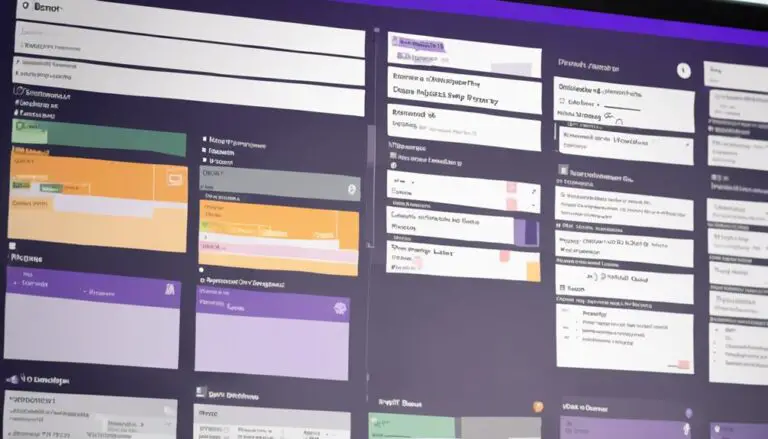When navigating the waters of Kanban velocity estimation, imagine your team as skilled sailors carefully measuring the winds and tides to chart a course toward success. Understanding the nuances of estimating velocity is crucial for achieving sustainable progress and meeting project deadlines effectively.
By exploring key factors influencing velocity, aligning team capacity with workload, and leveraging historical data insights, you can unlock the secrets to accurate forecasting and continuous improvement.
Stay tuned to discover how these strategies can propel your Kanban team to greater efficiency and value delivery.
Key Takeaways
- Analyzing historical data is crucial for accurate velocity estimation in Kanban teams.
- Balancing team capacity with workload ensures efficient estimation and delivery.
- Matching skills to tasks enhances productivity and improves estimation accuracy.
- Continuous refinement of estimation techniques through data analysis optimizes value delivery.
Factors Affecting Velocity Estimation
Understanding the key factors that influence velocity estimation is essential for Kanban teams aiming to improve their forecasting accuracy. When it comes to velocity estimation, historical data plays a critical role. By analyzing past performance and completion rates, teams can better predict their future velocity and plan accordingly. However, it's important to consider the impact of changes in team composition. Any shifts in skill levels or team members can influence how quickly tasks are completed, thus affecting velocity estimates.
Moreover, external factors can also throw off velocity estimates. Dependencies between tasks or unexpected issues can disrupt the team's workflow and impact their ability to accurately estimate velocity. To combat these challenges, regular retrospectives are vital. By reflecting on past performance and making adjustments based on actual data, teams can refine their velocity estimation over time. This iterative process allows teams to adapt to changing circumstances and continuously improve their forecasting accuracy.
Team Capacity Considerations
Let's kick off our exploration of Team Capacity Considerations by highlighting some key points:
Team Size Impact, Workload Distribution Strategies, and Skill Set Matching.
These factors play a crucial role in determining how much work your team can handle effectively and efficiently.
Team Size Impact
To optimize your Kanban team's performance, consider the impact of team size on capacity and coordination efficiency. Team size directly affects the capacity of your Kanban team to handle work effectively. A larger team may have a higher capacity, but it could encounter challenges in coordination.
On the other hand, smaller teams are more agile but might struggle with limited capacity for managing multiple tasks concurrently. Understanding these dynamics is crucial for accurately estimating velocity.
Balancing team size with workload is essential for ensuring optimal performance. By finding the right equilibrium between team size and workload, you can enhance coordination efficiency and overall productivity within your Kanban team.
Workload Distribution Strategies
Optimizing your Kanban team's performance hinges on strategically distributing workloads to maximize team capacity and efficiency in estimating velocity. Understanding your team members' individual capacities and expertise is key to balancing workloads effectively for accurate velocity predictions.
By assigning tasks based on team members' skills and availability, you can boost efficiency and overall team capacity. Balanced workload distribution ensures that each team member is working at their optimal level, leading to improved velocity estimates.
Regularly monitoring and adjusting workload allocations, guided by team feedback and performance data, further refines your velocity estimation process. By fine-tuning workload distribution strategies based on team capacity considerations, you pave the way for more precise velocity estimates in your Kanban workflow.
Skill Set Matching
Aligning team members' expertise with tasks is essential for effectively estimating velocity in Kanban teams. When considering team capacity for velocity estimation, matching skills to tasks has a significant impact on performance.
Here are some key points to keep in mind:
- Identifying Bottlenecks: Matching skills helps in pinpointing potential bottlenecks within the workflow.
- Optimizing Team Performance: Utilizing individual skills efficiently can lead to improved team productivity.
- Enhancing Collaboration: Skill set matching fosters a collaborative environment where team members can support each other.
- Improving Estimation Accuracy: Diverse skill sets contribute to more accurate velocity estimation, leading to better delivery predictability.
Importance of Historical Data Analysis
Analyzing historical data allows you to leverage past performance trends, learn from fluctuations, and enhance your future velocity predictions.
By understanding how your team has performed in the past, you can make more informed decisions about capacity planning and process optimizations.
Utilizing historical data enables you to adapt and optimize your workflow iteratively, leading to more reliable velocity estimates over time.
Utilizing Past Performance
By examining historical data, Kanban teams gain valuable insights into their past performance and enhance their ability to estimate velocity effectively for future tasks. Leveraging past performance data allows teams to make informed decisions and improvements based on what's worked well previously.
Here are some ways Kanban teams can benefit from utilizing past performance:
- Identifying Patterns: Recognize trends in team velocity over time.
- Capacity Adjustments: Make informed decisions on adjusting team capacity based on past outcomes.
- Estimation Accuracy: Improve accuracy in estimating velocity for upcoming tasks.
- Workflow Optimization: Optimize workflow efficiency by learning from past performance.
Analyzing historical data is key to continuous improvement and successful estimation in Kanban workflows.
Learning From Trends
To enhance your Kanban team's estimation accuracy and workflow efficiency, understanding and learning from trends in historical data analysis is crucial. Analyzing historical data helps Kanban teams identify patterns and fluctuations in their velocity over time.
By studying past performance, you can make more accurate predictions regarding future velocity estimation. Detecting trends through historical data analysis enables you to anticipate potential bottlenecks or areas for improvement in your team's performance.
This insight empowers Kanban teams to make data-driven decisions when planning and executing tasks. Embracing the value of historical data not only enhances your velocity estimation but also fosters a culture of continuous improvement within your team.
Stay proactive by leveraging these trends to drive success in your Kanban projects.
Enhancing Future Predictions
Improve your team's future prediction accuracy by delving into the insights gleaned from historical data analysis. By understanding historical velocity data, you can enhance your team's ability to estimate and plan effectively. Here are some key benefits of analyzing historical data:
- Identifying patterns: Historical data analysis helps in recognizing trends in velocity fluctuations.
- Understanding influences: It allows pinpointing factors that have impacted velocity in the past.
- Enhancing predictions: By studying historical data, you can make more accurate forecasts for future velocity.
- Effective planning: Utilizing insights from historical data aids in better estimation and planning processes.
Continuous Improvement Strategies for Velocity
Embrace a culture of continuous learning and adaptation within your Kanban team to enhance velocity estimation practices. Implement retrospective meetings to reflect on past performance data and identify areas for improvement in estimation accuracy.
Utilize Monte Carlo simulations to explore various outcomes and enhance the precision of your estimations. Encourage collaboration and feedback among team members to refine estimation techniques and increase accuracy over time.
Incorporate historical data analysis to uncover trends, patterns, and outliers that can assist in making more accurate velocity predictions. By adjusting your estimation approaches based on feedback loops and lessons learned, you can continuously improve your velocity estimation practices.
Forecasting Timelines With Velocity Estimation
Start by analyzing past completion rates to effectively forecast timelines with velocity estimation in Kanban. By understanding your team's historical performance and throughput, you can calculate an average velocity to make more accurate estimations.
Here are some tips to help you forecast timelines successfully:
- Track Completion Rates: Monitor completed issues or story points over time to calculate your team's average velocity.
- Evaluate Throughput: Understand your team's throughput to assess how much work can be completed within a given time frame.
- Set Realistic Expectations: Use velocity estimation to establish realistic project delivery timelines based on your team's historical performance.
- Adapt to Changes: Adjust your velocity estimation as needed based on changes in team composition, workload, or process improvements to enhance accuracy.
Enhancing Value Delivery Through Velocity
To optimize value delivery through velocity in Kanban, consider leveraging your team's historical performance data and throughput insights to enhance your forecasting accuracy and resource utilization. By analyzing your team's velocity metrics, you can gain a deeper understanding of your capacity and improve estimation for future releases. Tracking velocity allows you to identify trends and patterns in your workflow, highlighting areas for improvement and enhancing overall efficiency.
Through monitoring throughput and comparing it across different time frames, you can track your progress and assess your team's productivity. This insight enables you to pinpoint bottlenecks in your process, leading to targeted enhancements that boost value delivery. By continuously refining your estimation techniques based on velocity data, you can streamline your workflow, optimize resource allocation, and ensure that your team operates at its highest potential. Embracing the power of velocity in Kanban empowers your team to consistently improve and deliver value effectively.
Key Aspects in Estimating Velocity
Enhancing your Kanban team's estimation of velocity begins with a keen focus on key aspects that drive accurate forecasting and resource allocation. When estimating velocity in Kanban, consider the following: Understanding the team’s historical velocity by analyzing past performance and identifying any potential bottlenecks or variations in workflow is essential. Additionally, fostering open communication and collaboration within the team can help align everyone on their expectations and priorities. Ultimately, enhancing kanban team efficiency requires a continuous effort to improve estimation accuracy and adapt to any changes in the team’s dynamics or project requirements.
- Historical Data: Utilize past completed issues data to forecast future velocity more accurately.
- Team Capacity: Understand your team's capacity to ensure realistic velocity estimations.
- Throughput: Analyze historical throughput to gauge the team's efficiency in handling work items.
- Planning: Use velocity estimation for better planning by focusing on the steady flow of work items rather than fixed sprint durations.
Best Practices for Velocity Estimation
For effective velocity estimation in Kanban teams, focus on implementing best practices that center around tracking completed work items and utilizing key metrics like burned story points. By monitoring the number of completed tasks per week or month, Kanban teams can gain insights into their throughput, which is crucial for velocity estimation.
Calculating burned story points per month also aids in this process, providing a quantitative measure of work completed. Unlike Scrum, Kanban doesn't rely on time-boxed sprints, making it essential to track completed tasks continuously for accurate velocity estimation. Assessing velocity in Kanban helps teams understand their productivity, capacity, and overall performance, enabling better planning and forecasting.
Frequently Asked Questions
How Do Kanban Teams Estimate Their Velocity?
Estimating your team's velocity in Kanban involves tracking completed issues or story points per week/month. This helps gauge productivity, capacity, and efficiency. By focusing on cycle time analysis and setting work in progress limits, you enhance velocity accuracy and enable continuous improvement.
Can You Track Velocity in Kanban?
Yes, you can track velocity in Kanban by monitoring completed issues per week or burned story points per month. It aids in assessing productivity, efficiency, and capacity through continuous improvement, enhancing cycle time, lead time, throughput analysis, and work in progress.
How Do You Estimate Your Team's Velocity?
Estimating your team's velocity involves using methods like planning poker, story points, relative sizing, t-shirt sizing, expert judgment, and consensus-based estimation. By considering these techniques and team input, you can enhance accuracy in planning and forecasting.
How Can We Measure the Performance of the Team Using Kanban?
To measure your team's performance using Kanban, track agile measurements like throughput analysis, cycle time, and work efficiency. Calculate performance metrics by monitoring completed issues per week and burned story points per month. Boost team productivity through continuous assessment.
Conclusion
As you navigate the Kanban journey, remember that estimating velocity is like steering a ship through turbulent waters. By analyzing historical data, optimizing team capacity, and embracing continuous improvement, you can chart a course towards smoother sailing.
Let velocity be your guiding star, guiding you towards efficient value delivery and success in your agile endeavors. Smooth seas ahead with effective velocity estimation as your compass.





